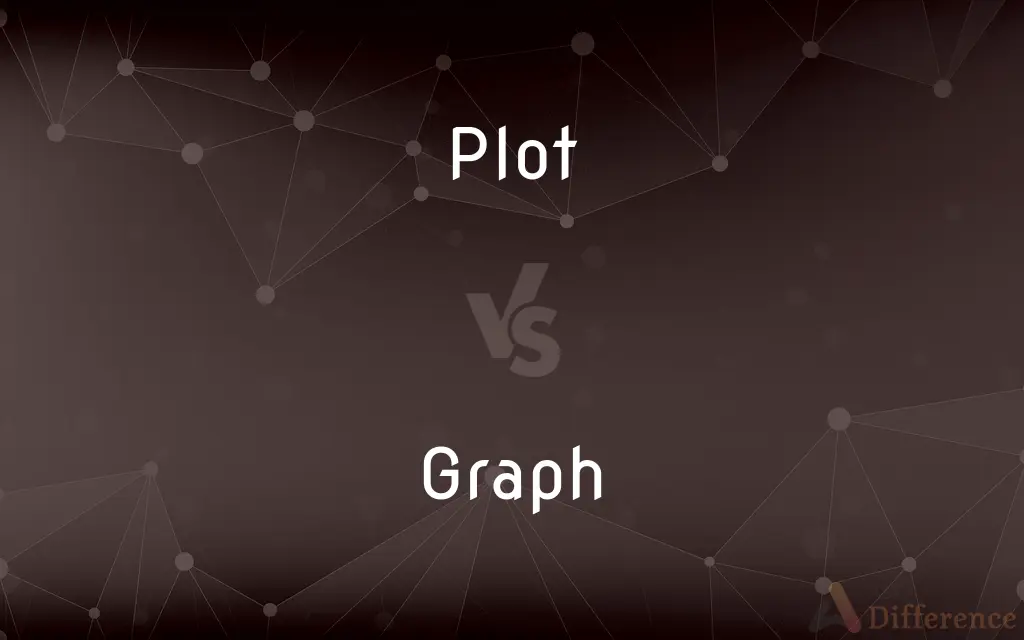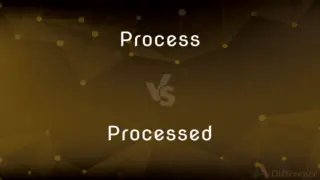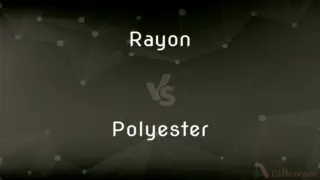Plot vs. Graph — What's the Difference?
By Fiza Rafique & Urooj Arif — Updated on March 8, 2024
A plot is a narrative structure in literature or storytelling, while a graph represents data visually in mathematics or science.

Difference Between Plot and Graph
Table of Contents
ADVERTISEMENT
Key Differences
A plot forms the backbone of a story, comprising the sequence of events and actions that characters undergo, designed to evoke emotional responses from the audience. On the other hand, a graph is a mathematical representation, using points, lines, bars, or other symbols to illustrate relationships between different variables or data sets.
The development of a plot involves characters, settings, and a series of events leading to a climax and resolution, creating a coherent and engaging story. Graphs, however, focus on depicting quantitative information, trends, or changes over time, enabling the analysis and interpretation of data without a narrative component.
Plots are essential in literature, film, and other narrative forms, serving as a tool for storytelling and engaging the audience through emotional and psychological experiences. Graphs are utilized in fields such as mathematics, science, economics, and business, where visual data representation is critical for understanding complex information.
The structure of a plot typically follows a defined pattern, such as the exposition, rising action, climax, falling action, and resolution, guiding the audience through the story. Graphs adhere to specific formats depending on their type (e.g., line graph, bar chart, pie chart), with axes, labels, and scales to present data clearly and efficiently.
While plots are crafted by authors or storytellers to convey themes, messages, or moral lessons through fictional or non-fictional narratives, graphs are created by researchers, analysts, or scientists to objectively present and analyze data, facilitating evidence-based conclusions without an inherent narrative.
ADVERTISEMENT
Comparison Chart
Definition
Narrative structure in storytelling
Visual representation of data
Components
Characters, events, climax, resolution
Data points, axes, labels, scales
Purpose
To engage and entertain
To analyze and interpret data
Use in
Literature, film, theater
Mathematics, science, economics
Key Feature
Emotional and psychological engagement
Objective and quantitative analysis
Compare with Definitions
Plot
The main storyline of a narrative work.
The plot of the novel revolves around a young detective solving a century-old mystery.
Graph
A diagram showing the relation between variable quantities, typically of two variables measured along a pair of axes at right angles.
The graph plotted the company's sales over the last year.
Plot
A piece of land used for a specific purpose.
They bought a small plot to start their organic garden.
Graph
A collection of points whose interconnections represent a set of relationships.
In computer science, a graph can represent networks of communication.
Plot
A plan or scheme, especially one used to outwit an opponent or achieve an end.
The movie's antagonist devises a complex plot to overthrow the government.
Graph
A written symbol representing a sound or a combination of sounds in phonetics.
Phonographemes are graphs that correspond to phonemes.
Plot
The sequence of events in a play, novel, movie, or similar work.
The play's plot thickens as the protagonist's past is revealed.
Graph
A chart used to compare data points in various categories.
The bar graph compared the productivity of different departments within the company.
Plot
A graphical representation in literature or film studies, showing the structure of a narrative.
The teacher drew a plot diagram to explain the story's development.
Graph
To plot or trace on a graph.
We graphed the temperature fluctuations over the month.
Plot
A plan made in secret by a group of people to do something illegal or harmful
There's a plot to overthrow the government
Graph
A diagram that exhibits a relationship, often functional, between two sets of numbers as a set of points having coordinates determined by the relationship. Also called plot.
Plot
The main events of a play, novel, film, or similar work, devised and presented by the writer as an interrelated sequence
The plot consists almost entirely of a man and woman falling in love
He outlined his idea for a movie plot
Graph
A pictorial device, such as a pie chart or bar graph, used to illustrate quantitative relationships. Also called chart.
Plot
A small piece of ground marked out for a purpose such as building or gardening
A vegetable plot
Graph
The spelling of a word.
Plot
A graph showing the relation between two variables.
Graph
Any of the possible forms of a grapheme.
Plot
Secretly make plans to carry out (an illegal or harmful action)
The two men are serving sentences for plotting a bomb campaign
Brother plots against brother
Graph
A written character that represents a vowel, consonant, syllable, word, or other expression and that cannot be further analyzed.
Plot
Devise the sequence of events in (a play, novel, film, or similar work)
In a crime story you have to plot carefully to achieve the surprise at the end
She would plot a chapter as she drove
Graph
To represent by a graph.
Plot
Mark (a route or position) on a chart
He started to plot lines of ancient sites
Graph
To plot (a function) on a graph.
Plot
A small piece of ground, generally used for a specific purpose
A garden plot.
Graph
A data chart (graphical representation of data) intended to illustrate the relationship between a set (or sets) of numbers (quantities, measurements or indicative numbers) and a reference set, whose elements are indexed to those of the former set(s) and may or may not be numbers.
Plot
A measured area of land; a lot.
Graph
(mathematics) A set of points constituting a graphical representation of a real function; (formally) a set of tuples , where for a given function . See also Graph of a function Category:en:Curves Category:en:Functions
Plot
A ground plan, as for a building; a diagram.
Graph
(graph theory) A set of vertices (or nodes) connected together by edges; (formally) an ordered pair of sets , where the elements of are called vertices or nodes and is a set of pairs (called edges) of elements of . See also Graph (discrete mathematics)
Plot
See graph1.
Graph
(topology) A topological space which represents some graph (ordered pair of sets) and which is constructed by representing the vertices as points and the edges as copies of the real interval [0,1] (where, for any given edge, 0 and 1 are identified with the points representing the two vertices) and equipping the result with a particular topology called the graph topology.
Plot
The pattern or sequence of interrelated events in a work of fiction, as a novel or film.
Graph
A morphism from the domain of to the product of the domain and codomain of , such that the first projection applied to equals the identity of the domain, and the second projection applied to is equal to .
Plot
A secret plan to accomplish a hostile or illegal purpose; a scheme.
Graph
A graphical unit on the token-level, the abstracted fundamental shape of a character or letter as distinct from its ductus (realization in a particular typeface or handwriting on the instance-level) and as distinct by a grapheme on the type-level by not fundamentally distinguishing meaning.
Plot
To represent graphically, as on a chart
Plot a ship's course.
Graph
(transitive) To draw a graph.
Plot
To locate (points or other figures) on a graph by means of coordinates.
Graph
To draw a graph of a function.
Plot
To draw (a curve) connecting points on a graph.
Graph
A curve or surface, the locus of a point whose coördinates are the variables in the equation of the locus; as, a graph of the exponential function.
Plot
To write or develop the plot of
"I began plotting novels at about the time I learned to read" (James Baldwin).
Graph
A diagram symbolizing a system of interrelations of variable quantities using points represented by spots, or by lines to represent the relations of continuous variables. More than one set of interrelations may be presented on one graph, in which case the spots or lines are typically distinguishable from each other, as by color, shape, thickness, continuity, etc. A diagram in which relationships between variables are represented by other visual means is sometimes called a graph, as in a bar graph, but may also be called a chart.
Plot
To form a plot for; prearrange secretly or deviously
Plot an assassination.
Graph
A drawing illustrating the relations between certain quantities plotted with reference to a set of axes
Plot
To form or take part in a plot; scheme
Were plotting for months before the attack.
Graph
Represent by means of a graph;
Chart the data
Plot
To write or develop the plot for a work of fiction
A good mystery writer must plot well.
Graph
Plot upon a graph
Plot
(narratology) The course of a story, comprising a series of incidents which are gradually unfolded, sometimes by unexpected means.
Plot
An area or land used for building on or planting on.
Plot
A graph or diagram drawn by hand or produced by a mechanical or electronic device.
Plot
A secret plan to achieve an end, the end or means usually being illegal or otherwise questionable.
The plot would have enabled them to get a majority on the board.
The assassination of Lincoln was part of a larger plot.
Plot
Contrivance; deep reach thought; ability to plot or intrigue.
Plot
Participation in any stratagem or conspiracy.
Plot
A plan; a purpose.
Plot
Attractive physical attributes of characters involved in a story, originating from ironic juxtaposition with the original meaning (course of the story).
I'm not sure what's happening in that show, I mainly watch it for the plot.
Plot
To conceive (a crime, misdeed etc).
They had plotted a robbery.
They were plotting against the king.
Plot
(transitive) To trace out (a graph or diagram).
They plotted the number of edits per day.
Plot
(transitive) To mark (a point on a graph, chart, etc).
Every five minutes they plotted their position.
Plot
A small extent of ground; a plat; as, a garden plot.
Plot
A plantation laid out.
Plot
A plan or draught of a field, farm, estate, etc., drawn to a scale.
Plot
Any scheme, stratagem, secret design, or plan, of a complicated nature, adapted to the accomplishment of some purpose, usually a treacherous and mischievous one; a conspiracy; an intrigue; as, the Rye-house Plot.
I have overheard a plot of death.
O, think what anxious moments pass betweenThe birth of plots and their last fatal periods!
Plot
A share in such a plot or scheme; a participation in any stratagem or conspiracy.
And when Christ saith, Who marries the divorced commits adultery, it is to be understood, if he had any plot in the divorce.
Plot
Contrivance; deep reach of thought; ability to plot or intrigue.
Plot
A plan; a purpose.
Plot
In fiction, the story of a play, novel, romance, or poem, comprising a complication of incidents which are gradually unfolded, sometimes by unexpected means.
If the plot or intrigue must be natural, and such as springs from the subject, then the winding up of the plot must be a probable consequence of all that went before.
Plot
To make a plot, map, pr plan, of; to mark the position of on a plan; to delineate.
This treatise plotteth down Cornwall as it now standeth.
Plot
To form a scheme of mischief against another, especially against a government or those who administer it; to conspire.
The wicked plotteth against the just.
Plot
To contrive a plan or stratagem; to scheme.
The prince did plot to be secretly gone.
Plot
To plan; to scheme; to devise; to contrive secretly.
Plot
A secret scheme to do something (especially something underhand or illegal);
They concocted a plot to discredit the governor
I saw through his little game from the start
Plot
A small area of ground covered by specific vegetation;
A bean plot
A cabbage patch
A briar patch
Plot
The story that is told in a novel or play or movie etc.;
The characters were well drawn but the plot was banal
Plot
A chart or map showing the movements or progress of an object
Plot
Plan secretly, usually something illegal;
They plotted the overthrow fo the government
Plot
Make a schematic or technical drawing of that shows how things work or how they are constructed
Plot
Make a plat of;
Plat the town
Common Curiosities
Can a plot exist without characters?
Generally, a plot involves characters whose actions and decisions drive the narrative forward. However, in some experimental or non-traditional narratives, the "characters" could be ideas or abstract concepts.
How does a graph differ from a plot in its use?
A graph is used to visually represent data, aiding in the analysis and interpretation of quantitative information, whereas a plot is used in storytelling to outline the sequence of events in a narrative.
Are graphs only used in scientific fields?
While graphs are extensively used in scientific and mathematical fields, they are also used in business, economics, education, and anywhere data visualization is beneficial.
Is a plot only relevant to fiction?
While plots are most commonly associated with fiction, they can also be found in non-fiction narratives where factual events are structured in a compelling and engaging manner.
What skills are necessary to interpret plots and graphs?
Interpreting plots requires narrative analysis and comprehension skills, while graph interpretation involves numerical literacy and the ability to understand visual data representations.
Can the structure of a plot vary?
Yes, while many plots follow a traditional structure, they can vary greatly, especially in non-linear narratives or stories that employ unconventional storytelling techniques.
What is the purpose of a plot in a story?
The purpose of a plot is to structure the narrative, connecting events in a meaningful way to engage and entertain the audience through emotional and psychological experiences.
What types of graphs are commonly used?
Common types of graphs include line graphs, bar charts, pie charts, scatter plots, and histograms, each suited to different kinds of data and analysis.
What is the difference between a plot and a graph?
A plot typically refers to the storyline or sequence of events in a narrative, while a graph is a diagram showing the relationship between variables, often used in mathematics and science.
Is a graph always related to mathematics?
While graphs are widely used in mathematics, they are also utilized in various fields such as economics, science, and business for data analysis and visualization.
How important is accuracy in a graph?
Accuracy in a graph is crucial as it represents objective data. Misrepresentation or inaccuracies can lead to incorrect conclusions and misinterpretations of the data.
Can a plot be visualized like a graph?
Yes, a plot can be visualized using a plot diagram or narrative arc, but it differs from a graph as it represents story elements rather than numerical data.
How do plot and graph contribute to understanding a story or data?
A plot helps understand the sequence and structure of a narrative, while a graph aids in visualizing and interpreting data relationships and trends.
How do plots and graphs vary in complexity?
Plots can range from simple to complex, depending on the narrative structure, while graphs can vary in complexity based on the data set and the type of graph used.
Can a graph be part of a plot in a story?
Yes, a graph can be part of a plot in a story, especially in genres like science fiction or academic narratives, where data plays a key role in the storyline.
Share Your Discovery

Previous Comparison
Process vs. Processed
Next Comparison
Rayon vs. PolyesterAuthor Spotlight
Written by
Fiza RafiqueFiza Rafique is a skilled content writer at AskDifference.com, where she meticulously refines and enhances written pieces. Drawing from her vast editorial expertise, Fiza ensures clarity, accuracy, and precision in every article. Passionate about language, she continually seeks to elevate the quality of content for readers worldwide.
Co-written by
Urooj ArifUrooj is a skilled content writer at Ask Difference, known for her exceptional ability to simplify complex topics into engaging and informative content. With a passion for research and a flair for clear, concise writing, she consistently delivers articles that resonate with our diverse audience.














































